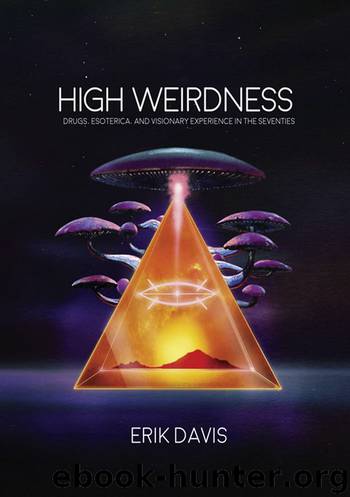High Weirdness (The MIT Press) by Erik Davis

Author:Erik Davis [Davis, Erik]
Language: eng
Format: epub, azw3
Tags: Psychedelic Studies, Literary Studies, Science Fiction, Histories of Consciousness, Religious Studies, Counterculture, Magic, The Occult, Terrence McKenna, Philip K. Dick, Robert Anton Wilson, 1970s, psychedelics, religious experience, mysticism, occultism, esoteric studies, spirituality, bohemia, drugs, psychosis, social constructivism, William James, Bruno Latour, LSD, cannabis, psilocybin, Timothy Leary, John Lilly, H.P. Lovecraft, Aleister Crowley, libertarianism, ufology, Discordianism, anarchism, weird literature, speculative realism, science fiction, Thelema, pragmatism, cultural history, California, consensus reality
Publisher: The MIT Press
Published: 2019-10-10T22:00:00+00:00
As we will discuss further in the Conclusion, the “network” here is not just any old figure. Within the context of seventies consciousness culture, the network played a crucial analogic role, at once invoking interlinked computers, underground subcultures, media webworks, and non-hierarchical forms of organization. For Wilson, the network suggested by Luna's and Leary's text was a Network of Love, no longer “one hypothesis among many” but, for a spell, an omnipresent reality. “Once my eyes were truly open to it, the Network was everywhere, in every tree, every flower, in the sky itself, and the golden merry light that had been Luna was part of it.”98
The term network puts a technical spin on the benign conspiracy of friends and family that surrounded Wilson, even as it also affirmed the void of Luna's absence. But the figure of the network also suggests something about the very form of such pregnant coincidences, a “synchronicity mesh” that does not tell stories so much as build a matrix of implications distributed non-hierarchically throughout spacetime. Of course, such a lattice can appear oppressive as well as liberating and loving; one person's blissful realization that “everything is connected” is another person's terrifying glimpse into the locked grooves of a cosmic prison. The signs, events, and texts that constitute Cosmic Trigger's own “lattice of coincidence” leave this particular question of emotional valence open and unresolved. As Luna's own poem suggests, even the discovery of the deeper patterns that organize the world cannot be separated from the baffling abyss that frames them—an abyss that, sometimes, stares back, and even whispers.
Download
This site does not store any files on its server. We only index and link to content provided by other sites. Please contact the content providers to delete copyright contents if any and email us, we'll remove relevant links or contents immediately.
Becoming Supernatural by Dr. Joe Dispenza(8092)
Crystal Healing for Women by Mariah K. Lyons(7842)
The Witchcraft of Salem Village by Shirley Jackson(7171)
Inner Engineering: A Yogi's Guide to Joy by Sadhguru(6705)
The Four Agreements by Don Miguel Ruiz(6597)
The Power of Now: A Guide to Spiritual Enlightenment by Eckhart Tolle(5584)
Secrets of Antigravity Propulsion: Tesla, UFOs, and Classified Aerospace Technology by Ph.D. Paul A. Laviolette(5299)
The Wisdom of Sundays by Oprah Winfrey(5067)
Room 212 by Kate Stewart(5014)
Pale Blue Dot by Carl Sagan(4886)
Fear by Osho(4644)
The David Icke Guide to the Global Conspiracy (and how to end it) by David Icke(4606)
Animal Frequency by Melissa Alvarez(4382)
Rising Strong by Brene Brown(4362)
How to Change Your Mind by Michael Pollan(4275)
Sigil Witchery by Laura Tempest Zakroff(4162)
Real Magic by Dean Radin PhD(4063)
Man and His Symbols by Carl Gustav Jung(4056)
The Art of Happiness by The Dalai Lama(4051)
